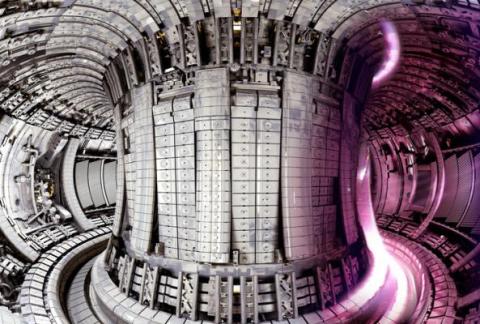JET’s final deuterium-tritium results revealed one year on
One year after the conclusion of JET's final scientific experiments, crucial findings are emerging that will help advance future fusion machines.
One year after the conclusion of the Joint European Torus (JET)’s final scientific experiments, crucial findings are emerging that will play a key role in advancing future fusion machines.
These findings have resulted in the submission of 96 research papers to various scientific journals, including 18 led by UKAEA scientist as first authors in 2024 alone.
JET, located at United Kingdom Atomic Energy Authority’s (UKAEA) Culham Campus in Oxfordshire, was one of the world’s largest and most powerful operational tokamaks.
It was until recently the only tokamak able to use the hydrogen isotopes, deuterium and tritium, in its fuel mix to produce fusion plasmas. This fuel combination is regarded as the powerplant-grade fuel of the future.
JET’s final deuterium-tritium experiments, also known as ‘DTE3’, focused on three key areas:
- Plasma science
- Materials science
- Neutronics
Several impactful achievements from the DTE3 experiments are advancing the understanding of plasma science and operational techniques for future tokamaks, including:
Plasma science
A significant reduction in the high heat impact on the machine’s inner walls, enhancing durability and efficiency.
Deeper insights into the periodical instability that occurs in the edge of the plasma in tokamaks, known as Edge Localised Modes (ELMs), which are critical to maintaining plasma confinement.
The first successful demonstration of controlling high fusion power in real-time by adjusting the mix of deuterium and tritium in the fuel, essential for maintaining stable plasma conditions.
Materials science
The pioneering use of lasers to measure the amount of tritium deposited on the machine’s inner walls between plasma experiments, enabling more precise fuel management and recycling.
Neutronics
In-depth analysis of the impact of neutrons on the various machine components, conducted only for the second time in a tokamak environment using powerplant-grade fuels. This testing involved materials such as tungsten and the alloys, cooper chromium zirconium (CuCrZr) and EUROFER – chosen for their high thermal resilience and low activation properties. The findings have enhanced confidence in predicting activation levels in these materials during fusion operations.
Such findings can be found in several academic journals such as Nuclear Fusion, Nuclear Materials and Energy, Physics of Plasma, Plasma Physics and Controlled Fusion, and Review of Scientific Instruments.
Further JET experiments after DTE3
Beyond these experiments, JET’s DTE3 experiments also provided valuable insights into optimising materials for use in extreme environments, improving inner-vessel efficiency and informing the designs of next generation fusion machines.
Following the DTE3 experiments, final deuterium-deuterium experiments were conducted during which they pushed JET’s operational boundaries.
A notable achievement was the successful use of negative triangularity, also known as an ‘inverted plasma configuration’, in pulses lasting up to a minute for the first time. A pulse is the duration a plasma is maintained within the machine’s inner vessel.
The use of negative triangularity showed an improvement to the plasma’s performance, enhancing confinement and plasma stability.
Negative triangularity in a fusion plasma refers to plasma’s specific shape inside a tokamak.
In this configuration, the plasma’s top and bottom curves bend inward, giving it a D-like appearance. This contrasts with the more common positive triangularity, where the top and bottom of the plasma curve outward.
Joelle Mailloux, JET Science Programme Leader at UKAEA, said, “ Over the past year, UKAEA has carried out data validation and diagnostics calibrations, ensuring the data quality corresponds to the exceptional results of the JET experiments in 2022 and 2023. This has allowed more than 300 EUROfusion scientists from 30 research units from across Europe, including UKAEA to analyse and model the data from JET.”
Collaborative workshops have been hosted at UKAEA’s Culham Campus to boost the data analysis of DTE3, to complete the understanding of the physics mechanisms behind the results and explore their applicability to future tokamaks using deuterium and tritium fuels through numerical simulations. More workshops are planned in the coming years to continue this critical work.
JET ceased plasma operations in December 2023 and has transitioned into the next stage of its lifecycle: the JET Decommissioning and Repurposing programme.
The learnings from repurposing and decommissioning JET are expected to last until c.2040, in which time it will provide unparalleled insights to aid the design and development of future fusion machines.
JET demonstrated its capability to consistently generate fusion energy, achieving a world record in 2023 by producing 69 megajoules of high power over five seconds. This feat was accomplished using just 0.2. milligrams of fuel – the equivalent weight of a fruit fly.
UKAEA is continuing to conduct experiments through its MAST Upgrade machine.
Photo: JET interior with superimposed plasma (United Kingdom Atomic Energy Authority). Image Credit: United Kingdom Atomic Energy Authority










